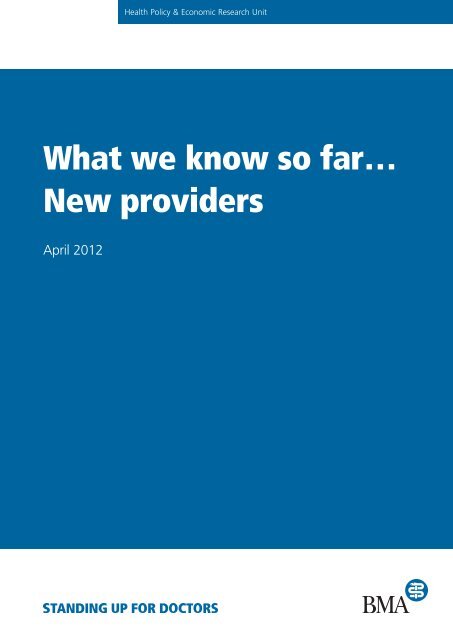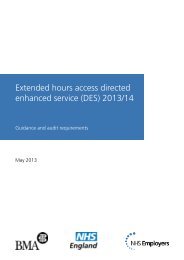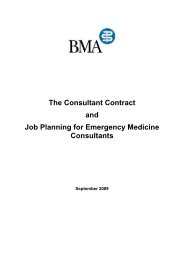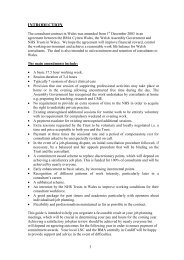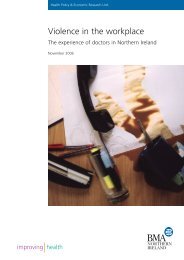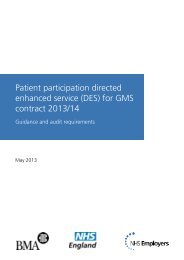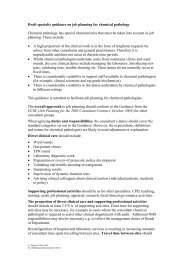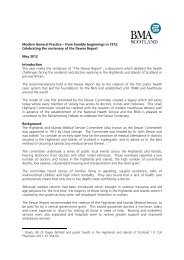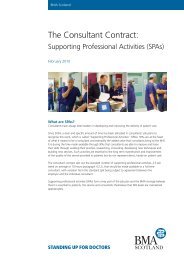What we know so far… New providers - BMA
What we know so far… New providers - BMA
What we know so far… New providers - BMA
Create successful ePaper yourself
Turn your PDF publications into a flip-book with our unique Google optimized e-Paper software.
Health Policy & Economic Research Unit<br />
<strong>What</strong> <strong>we</strong> <strong>know</strong> <strong>so</strong> <strong>far…</strong><br />
<strong>New</strong> <strong>providers</strong><br />
April 2012
Health Policy & Economic Research Unit<br />
Contents<br />
1. <strong>What</strong> <strong>we</strong> <strong>know</strong> <strong>so</strong> <strong>far…</strong><br />
2. Introduction<br />
3. <strong>New</strong> provider models before the White Paper<br />
3.1 Independent Sector Treatment Centres (ISTCs)<br />
3.1.1 Introduction of ISTCs<br />
3.1.2 Financial implications<br />
3.1.3 <strong>BMA</strong> concerns<br />
3.2 Social Enterprise<br />
3.2.1 Introduction of <strong>so</strong>cial enterprises<br />
3.2.2 Transforming Community Services<br />
3.2.3 Right to request<br />
3.2.4 Transfer of staff<br />
3.2.5 <strong>BMA</strong> concerns<br />
3.3 Not-for-profit <strong>providers</strong><br />
4. Changes in the NHS<br />
4.1 Any Qualified Provider<br />
4.2 Failure regime<br />
4.3 ISTCs<br />
4.4 Social Enterprise<br />
4.5 Not-for-profit sector<br />
5. <strong>What</strong> <strong>we</strong> don't <strong>know</strong><br />
<strong>What</strong> <strong>we</strong> <strong>know</strong> <strong>so</strong> <strong>far…</strong> <strong>New</strong> <strong>providers</strong> 1
2<br />
Health Policy & Economic Research Unit<br />
1. <strong>What</strong> <strong>we</strong> <strong>know</strong> <strong>so</strong> <strong>far…</strong><br />
This paper forms part of a series of <strong>BMA</strong> briefing papers, which set out what <strong>we</strong> <strong>know</strong> <strong>so</strong> far on a<br />
range of key topics following the Government’s health reforms.<br />
The Health and Social Care Act 2012, which concluded its 15-month passage through Parliament on<br />
20 March and received Royal Assent on 27 March, now defines much of the Government’s proposals<br />
in primary legislation. The Act legislates for the NHS reforms first set out in the White Paper, Equity and<br />
excellence: Liberating the NHS 1<br />
, which was published in July 2010.<br />
This briefing note describes what the changes will mean for new <strong>providers</strong>, identifying uncertainties<br />
that remain around implementation and where proposals will be further developed through secondary<br />
legislation and guidance.<br />
Where of significance, the papers highlight changes that have been made to the Government’s original<br />
proposals for reform through the parliamentary process, but otherwise reflect the information/detail of<br />
where <strong>we</strong> are now.<br />
The briefing papers focus on bringing together the available facts and drawing attention to gaps in<br />
<strong>know</strong>ledge rather than giving an account of <strong>BMA</strong> policy. Documents stating the <strong>BMA</strong>’s policies and<br />
positions are referenced in the papers where appropriate, to allow readers to examine these in more<br />
detail if they wish to do <strong>so</strong>.<br />
They are living documents and will be updated as and when new information emerges. We would be<br />
interested to hear your views, and any information you may have, on the various topics covered in the<br />
briefing papers. Please use the contact details below to get in touch.<br />
Contact us<br />
Health Policy and Economic Research Unit<br />
info.hperu@bma.org.uk<br />
<strong>BMA</strong> House, Tavistock Square, London WC1H 9JP<br />
1 Department of Health. Equity and excellence: Liberating the NHS. 2010.<br />
<strong>What</strong> <strong>we</strong> <strong>know</strong> <strong>so</strong> <strong>far…</strong> <strong>New</strong> <strong>providers</strong>
Health Policy & Economic Research Unit<br />
2. Introduction<br />
<strong>New</strong> forms of provider models have entered the NHS in the last decade following the introduction of<br />
the internal market and the purchaser-provider split in the NHS in 1990. These new models include:<br />
foundation trusts 2<br />
, and independent sector treatment centres (ISTCs) in the secondary and tertiary care<br />
sectors, and <strong>so</strong>cial enterprises and not-for-profit <strong>providers</strong> in the primary and community care sectors.<br />
To facilitate the entry of new <strong>providers</strong> to the internal market the Labour Government introduced a<br />
series of initiatives including: practice based commissioning, a national tariff for certain services <strong>know</strong>n<br />
as ‘Payment by Results’, the extended choice network (ECN) and free choice network (FCN), NHS<br />
Choices 3<br />
, Choose and Book, Transforming Community Services and the NHS Constitution. These<br />
policies all contributed to a movement towards greater choice and competition in the NHS 4<br />
.<br />
The publication of the White Paper ‘Equity and excellence: Liberating the NHS’ in July 2010<br />
introduced the new Coalition Government’s plans to reform the health service which <strong>so</strong>ught to<br />
encourage proliferation of the new forms of <strong>providers</strong> and complete the purchaser-provider split.<br />
2 See the briefing note <strong>What</strong> <strong>we</strong> <strong>know</strong> <strong>so</strong> far … foundation trusts for more information.<br />
3 NHS Choices briefing note. <strong>BMA</strong>, October 2010<br />
http://bma.org.uk/working-for-change/shaping-healthcare/competition-and-choice<br />
4 See the briefing note <strong>What</strong> <strong>we</strong> <strong>know</strong> <strong>so</strong> far … Choice and any qualified provider for more information.<br />
<strong>What</strong> <strong>we</strong> <strong>know</strong> <strong>so</strong> <strong>far…</strong> <strong>New</strong> <strong>providers</strong> 3
4<br />
Health Policy & Economic Research Unit<br />
3. <strong>New</strong> provider models before the<br />
White Paper<br />
3.1 Independent Sector Treatment Centres (ISTCs)<br />
ISTCs are non-NHS organisations that provide secondary care services to NHS patients, usually performing<br />
common elective and diagnostic procedures.<br />
3.1.1 Introduction of ISTCs<br />
ISTCs <strong>we</strong>re introduced by the Labour Government in 2003 with the intention of increasing capacity in the<br />
health service in order to reduce waiting times. This follo<strong>we</strong>d concerns that hospitals <strong>we</strong>re often cancelling<br />
planned procedures due to the competing demand of providing emergency care. Moving elective<br />
operations to separate organisations was intended to remove this motive and drive down waiting times.<br />
There have been two ‘waves’ of ISTCs, both procured centrally with five year block contracts from<br />
the Department of Health. To facilitate use of ISTCs, choice for patients at referral to hospital was<br />
introduced on 1 January 2006 and most patients requiring an elective referral <strong>we</strong>re to be offered a choice<br />
of at least four hospitals.<br />
ISTCs – key facts<br />
• The first wave of ISTCs introduced 25 fixed-site centres, which <strong>we</strong>re awarded contracts in 2003 to<br />
deliver 170,000 consultant epi<strong>so</strong>des for £1.6 billion.<br />
• The second phase of ISTCs was introduced in 2005 resulting in nine schemes over multiple sites<br />
contracted to deliver 250,000 consultant epi<strong>so</strong>des and two million diagnostic procedures for<br />
£4 billion over five years.<br />
• 48 NHS-owned treatment centres have al<strong>so</strong> been developed since 2000 5<br />
.<br />
3.1.2 Financial implications<br />
Generally, ISTCs have been underused, with both wave one and wave two ISTCs performing around<br />
85 per cent of contracted activity and overall contributing only around 2 per cent of all NHS activity,<br />
therefore providing little extra capacity 6<br />
. As a result, the cost to the NHS has grown considerably,<br />
paying on average across the first 20 ISTCs 12 per cent more than the cost for the NHS to perform the<br />
work internally 7<br />
.<br />
3.1.3 <strong>BMA</strong> concerns<br />
The <strong>BMA</strong> has voiced a number of concerns with regard to the introduction of ISTCs including:<br />
• ISTCs ‘cherry picking’ straightforward cases resulting in a greater proportion of more complex cases<br />
treated within the NHS, which would raise the per capita cost of treatment for NHS <strong>providers</strong>.<br />
5 The King’s Fund. Independent Sector Treatment Centres. October 2009.<br />
6 King’s Fund, op. cit., p.3.<br />
7 http://www.publications.parliament.uk/pa/cm200708/cmselect/cmhealth/1190/1190w118.htm.<br />
<strong>What</strong> <strong>we</strong> <strong>know</strong> <strong>so</strong> <strong>far…</strong> <strong>New</strong> <strong>providers</strong>
Health Policy & Economic Research Unit<br />
• Fragmentation of patient care due to lack of communication bet<strong>we</strong>en organisations. Further detail<br />
is available in an HPERU study of the impact of treatment centres on the local health economy.<br />
• Education and training of the NHS workforce may al<strong>so</strong> be affected by the transfer of activity from<br />
the NHS to the private sector both through the distortion of NHS casemix and the removal of<br />
training opportunities where <strong>providers</strong> lack the facilities, or are not contractually obliged to<br />
provide training.<br />
3.2 Social Enterprise<br />
3.2.1 Introduction of <strong>so</strong>cial enterprises<br />
During its recent years in po<strong>we</strong>r the Labour Government started a policy shift towards <strong>so</strong>cial<br />
enterprises in the health sector with a number of initiatives. In January 2006, the Labour Government<br />
published the White Paper ‘Our Health, Our Care, Our Say: A <strong>New</strong> Direction for Community Services’.<br />
Amongst other policies, it emphasised that care could be delivered by a range of healthcare <strong>providers</strong><br />
including <strong>so</strong>cial enterprises. The Social Enterprise Unit (SEU) was established to promote the <strong>so</strong>cial<br />
enterprise sector within the NHS, and the £100m Social Enterprise Investment Fund was al<strong>so</strong> made<br />
accessible to health and <strong>so</strong>cial care <strong>so</strong>cial enterprises. Further detail on policy developments can be<br />
found in the HPERU briefing on <strong>so</strong>cial enterprises 8<br />
.<br />
3.2.2 Transforming Community Services<br />
In January 2009, the Labour Government decided to separate all commissioning and provision<br />
functions of PCTs. The Department of Health published ‘Transforming Community Services: Enabling<br />
<strong>New</strong> Patterns of Provision’ instructing PCTs to divest their provision arms to separate organisations<br />
using a national contract for community services. The intention was to break off PCT provider arms<br />
into <strong>so</strong>cial enterprises.<br />
3.2.3 Right to request<br />
The ‘Next Stage Review’ 9<br />
introduced the ‘Right to request’ in 2008. This established a right for NHS<br />
staff to set up <strong>so</strong>cial enterprises to deliver services. Support was provided to new organisations<br />
including a contract for up to five years as <strong>we</strong>ll as business development support. The Social Enterprise<br />
Investment Fund provided £8.3 million to ‘Right to Request’ applicants. The Scheme closed in<br />
September 2010 following the requirement that all PCTs separate commissioning and provision of<br />
community services by April 2011 10<br />
.<br />
8 <strong>BMA</strong>, Social enterprises in the health service. April 2011<br />
http://bma.org.uk/working-for-change/shaping-healthcare/competition-and-choice<br />
9 Department of Health. High quality care for all: Next stage review. June 2008.<br />
10 The King’s Fund. Social enterprise in health care: promoting organisational autonomy and staff engagement. August 2011.<br />
<strong>What</strong> <strong>we</strong> <strong>know</strong> <strong>so</strong> <strong>far…</strong> <strong>New</strong> <strong>providers</strong> 5
6<br />
Health Policy & Economic Research Unit<br />
3.2.4 Transfer of staff<br />
In order to ease the concerns of staff facing transferral from the NHS, the ‘Code of Practice on<br />
Workforce Matters in Public Sector Service Contracts’ was introduced by the Labour Government in<br />
2005. The Code set out an approach for transfer of staff from a public sector organisation to a new<br />
service provider. It was designed to prevent the emergence of a two-tier workforce and ensured that<br />
new starters would be on organisation-specific terms and conditions, which should be overall no less<br />
favourable than the terms and conditions of transferred employees.<br />
Social enterprises – key facts<br />
There are around 62,000 <strong>so</strong>cial enterprises in the UK, which contribute more than £24 billion to<br />
the economy, employing approximately 800,000 people. It is estimated that about 9 per cent of<br />
them (approximately 6000) operate in the health and <strong>so</strong>cial care sectors 11<br />
. There are 22 staff-run<br />
<strong>so</strong>cial enterprises, which <strong>we</strong>re set up under the ‘Transforming Community Services’ programme.<br />
3.2.5 <strong>BMA</strong> concerns<br />
The <strong>so</strong>cial enterprise model for healthcare is still relatively new in England and there is a lack of<br />
evidence assessing the effectiveness of early examples 12<br />
. The Department of Health’s assessment of the<br />
Social Enterprise Pathfinder Programme found a need for clarity around the model and a need to<br />
address staff concerns 13<br />
. There is little evidence to suggest significant numbers of NHS staff wish to<br />
work in <strong>so</strong>cial enterprises. In 2010, 73 per cent of staff in West Essex PCT (one of the ‘first wave’ <strong>so</strong>cial<br />
enterprise projects) voted against the setting up of, and transfer to, a <strong>so</strong>cial enterprise 14<br />
.<br />
3.3 Not-for-profit <strong>providers</strong><br />
The not-for-profit sector, including voluntary and charitable organisations 15<br />
, grew in terms of both<br />
income and employment over the lifetime of the Labour Government, which saw planned expansion<br />
of provision of public services by the sector. Increasingly funded by the state, the not-for-profit sector<br />
has seen a shift in income from grants to contracts to supply services. The sector has been identified by<br />
all major parties as a way of offloading public services, described as ‘the <strong>we</strong>apon of choice’ in the<br />
battle for public sector reform 16<br />
.<br />
11 The King’s Fund. Social enterprise in health care: promoting organisational autonomy and staff engagement. August 2011.<br />
12 Lewis, R., Hunt, P., Car<strong>so</strong>n, D. (2006) Social Enterprise and Community-based Care. The King’s Fund. p.10.<br />
13 Department of Health. Leading the way through <strong>so</strong>cial enterprise: the <strong>so</strong>cial enterprise pathfinder programme evaluation.<br />
March 2010. http://www.dh.gov.uk/en/Publicationsandstatistics/Publications/PublicationsPolicyAndGuidance/DH_113535.<br />
14 Social Enterprise Live, Staff vote halts plans for first ‘right to request’ <strong>so</strong>cial enterprise<br />
http://www.<strong>so</strong>cialenterpriselive.com/section/news/public-services/20100127/staff-vote-halts-plans-first-right-request-<strong>so</strong>cialenterprise.<br />
(accessed 18 November 2010).<br />
15 Some definitions of the not-for-profit sector include <strong>so</strong>cial enterprises. Ho<strong>we</strong>ver, in this case the definition refers to charitable<br />
and voluntary organisations.<br />
16 Uni<strong>so</strong>n. Third Sector provision of local government and health services. April 2007.<br />
<strong>What</strong> <strong>we</strong> <strong>know</strong> <strong>so</strong> <strong>far…</strong> <strong>New</strong> <strong>providers</strong>
Health Policy & Economic Research Unit<br />
Not-for-profit <strong>providers</strong> – Key facts<br />
In 2010 the As<strong>so</strong>ciation of Chief Executives of Voluntary Organisations (ACEVO) predicted<br />
voluntary sector income from providing public services could increase by £2 billion by 2015 and<br />
despite cuts in public funding, the sector’s share of grants and contracts with local and central<br />
government could continue to grow. Figures from the National Council for Voluntary<br />
Organisations (NCVO) sho<strong>we</strong>d the sector received about £12.8 billion a year in public grants and<br />
contracts in 2007/08 17<br />
.<br />
17 http://www.thirdsector.co.uk/news/1039628/Delivery-public-services-will-grow-despite-cuts.<br />
<strong>What</strong> <strong>we</strong> <strong>know</strong> <strong>so</strong> <strong>far…</strong> <strong>New</strong> <strong>providers</strong> 7
8<br />
Health Policy & Economic Research Unit<br />
4. Changes in the NHS<br />
The Health and Social Care Act 2012 introduces reforms to encourage more use of new <strong>providers</strong><br />
with the aim of giving patients access to a greater variety of <strong>providers</strong> and choose those that meet<br />
their needs.<br />
4.1 Any Qualified Provider<br />
One of the aims of the Government’s reforms is to extend choice of provider beyond elective surgery<br />
to other areas of care including community services, mental health and diagnostics.<br />
The new ‘Any Qualified Provider’ (AQP) policy is intended to aid the process of altering the NHS<br />
landscape to that of a broad range of <strong>providers</strong> from the private, voluntary and independent sectors.<br />
AQP will extend choice of provider for patients to new services expanding on the ‘Any Willing Provider’<br />
policy introduced in April 2008, which gave patients choice of provider for routine elective procedures.<br />
In July 2011 the Government announced the implementation of a phased role out of extended patient<br />
choice of AQP in response to the consultation Liberating the NHS: greater choice and control 18<br />
. This<br />
would mean that from April 2012 commissioners will be required to apply the extended choice of AQP<br />
to a minimum of three new services. A recommended list of eight community and mental health<br />
services was indicated as likely candidates to begin AQP.<br />
Providers will be qualified to provide the particular services under AQP arrangements if they:<br />
• Register with the CQC, and from 2013 with both CQC and Monitor;<br />
• Agree to the tariff set by commissioners;<br />
• Receive no guarantees of volume or payment;<br />
• Can demonstrate a track record of delivery of the service;<br />
• Agree to the terms and conditions of the standard NHS contract, and incorporate any local<br />
commissioner quality requirements or service specifications; and<br />
• Sign up to managing potential conflicts of interest explicitly and transparently ensuring patients are<br />
aware of their right to choose and the options available.<br />
For more information please see the briefing note, <strong>What</strong> <strong>we</strong> <strong>know</strong> <strong>so</strong> <strong>far…</strong>Choice and any qualified<br />
provider.<br />
18 Liberating the NHS: greater choice and control. Government response – extending choice of provider<br />
http://www.dh.gov.uk/en/Consultations/Responsestoconsultations/DH_125442.<br />
<strong>What</strong> <strong>we</strong> <strong>know</strong> <strong>so</strong> <strong>far…</strong> <strong>New</strong> <strong>providers</strong>
Health Policy & Economic Research Unit<br />
4.2 Failure regime<br />
The Health and Social Care Act 2012 legislates for a new failure regime. If an independent provider,<br />
including private <strong>providers</strong> and <strong>so</strong>cial enterprises, becomes unsustainable, a health special<br />
administration procedure will come into place. This will be based on existing corporate in<strong>so</strong>lvency law,<br />
details of which will be set out in secondary legislation. For more information, a separate briefing note<br />
on the failure regime will be available <strong>so</strong>on.<br />
4.3 ISTCs<br />
Before the entry of the current government, centrally negotiated ISTC contracts <strong>we</strong>re due to expire,<br />
with most wave one contracts concluding by 2009/10 and wave two contracts up to 2017. Following<br />
this, ISTCs would operate as other independent sector <strong>providers</strong> able to treat private patients, no<br />
longer subject to restrictions on employing NHS staff and free to compete for PCT contracts being<br />
automatically registered as ‘Any Qualified provider’ for the services they <strong>we</strong>re originally contracted to<br />
provide 19<br />
.<br />
As the first wave contracts have came to an end the shift from national to PCT-based contracting was<br />
delayed. For ISTCs this has meant moving from one Extended Choice Network/Free Choice Network<br />
(ECN/FCN) arrangement to several (up to 50) contracts with individual PCTs. Due to difficulties with the<br />
transition, the Government extended ECN contracts. Ho<strong>we</strong>ver, the majority of ISTCs now have PCTbased<br />
contracts in place 20<br />
. These contracting arrangements are now subject to further change with the<br />
abolition of PCTs and SHAs under the Health and Social Care Act. Interim arrangements have been<br />
introduced with SHA and PCT clusters, and Clinical Commissioning Groups will be able to refer<br />
patients to ISTCs through the Any Qualified Provider policy.<br />
4.4 Social Enterprise<br />
The Government has overtly announced its support for the Social Enterprises and PCT <strong>providers</strong><br />
continue to convert to this model. In March 2011, the Government announced the ‘Right to Provide’<br />
programme following similar arrangements to the previous ‘Right to Request’ programme, to<br />
encourage health and <strong>so</strong>cial care staff to create their own staff-led <strong>so</strong>cial enterprises. This means NHS<br />
staff can request to manage the services or care pathways they currently deliver by setting up their<br />
own organisation 21<br />
. Little detail is available regarding the extent to which this is being taken up. The<br />
initiative has been set up in the context of the Any Qualified Provider programme.<br />
The ‘Code of Practice on Workforce Matters in Public Sector Service Contracts’ was withdrawn in<br />
December 2010 and has been replaced by a set of ‘Principles of Good Employment Practice’ 22<br />
. The<br />
Principles are not mandatory and their adoption will not be part of the decision making process to<br />
approve <strong>providers</strong>. The Government has said that it will monitor the application of the Principles<br />
19 The King’s Fund. Op. cit. p.325 Cooperation and Competition Panel Review of the operation of ‘any willing provider’ for the<br />
provision of routine elective care: interim assessment. February 2011.<br />
20 Cooperation and Competition Panel Review of the operation of ‘any willing provider’ for the provision of routine elective care:<br />
interim assessment. February 2011.<br />
21 http://healthandcare.dh.gov.uk/rtp/.<br />
22 Cabinet Office. Principles of good employment practice. 2010<br />
http://www.cabinetoffice.gov.uk/re<strong>so</strong>urce-library/principles-good-employment-practice.<br />
<strong>What</strong> <strong>we</strong> <strong>know</strong> <strong>so</strong> <strong>far…</strong> <strong>New</strong> <strong>providers</strong> 9
10<br />
Health Policy & Economic Research Unit<br />
through the Public Services Forum which will give trade unions and public service employers the<br />
opportunity to feedback on the impact of the withdrawal of the ‘Code of Practice’ and the Principles.<br />
4.5 Not-for-profit sector<br />
Like its predeces<strong>so</strong>r, the coalition Government has expressed an interest in enabling the not-for-profit<br />
sector to provide public services as outlined in the ‘Big Society’ vision, which largely focuses on<br />
decentralisation of responsibility to communities and citizens. A greater role for the not-for-profit<br />
sector was al<strong>so</strong> backed by the NHS Future Forum report on Choice and Competition. The report cited<br />
current examples of third sector provision and identified that 70 per cent of the health service budget<br />
goes on long term conditions, which are seen to be amenable to third sector <strong>providers</strong> as the majority<br />
of this work is carried out in the community. Examples <strong>we</strong>re cited of third sector organisations that<br />
represent particular patient groups and have been influential in shaping services for certain conditions.<br />
<strong>What</strong> <strong>we</strong> <strong>know</strong> <strong>so</strong> <strong>far…</strong> <strong>New</strong> <strong>providers</strong>
Health Policy & Economic Research Unit<br />
5. <strong>What</strong> <strong>we</strong> don’t <strong>know</strong><br />
There is still uncertainty about how effective the reforms will be in promoting more competition in the<br />
NHS. There could potentially be significant changes ahead for new <strong>providers</strong>. Ho<strong>we</strong>ver, it could be<br />
<strong>so</strong>me time before the long-term effects become clear.<br />
It is yet to be seen how commissioners will interpret the Any Qualified Provider policy. There are many<br />
questions as to how the AQP policy will affect the different types of <strong>providers</strong> and how commissioners<br />
will address reconciling patient choice of provider and tendering contracts with <strong>providers</strong> for complex<br />
services. Although the details remain unclear it is likely that AQP will potentially further open up the<br />
market to new <strong>providers</strong>.<br />
<strong>What</strong> <strong>we</strong> <strong>know</strong> <strong>so</strong> <strong>far…</strong> <strong>New</strong> <strong>providers</strong> 11
12<br />
Health Policy & Economic Research Unit<br />
<strong>What</strong> <strong>we</strong> <strong>know</strong> <strong>so</strong> <strong>far…</strong> new <strong>providers</strong>


